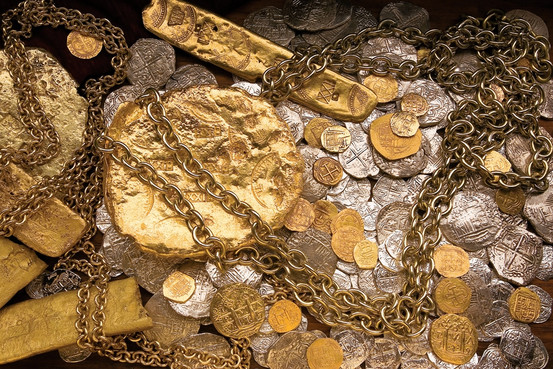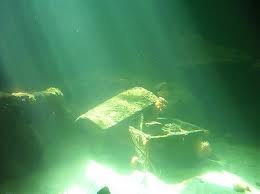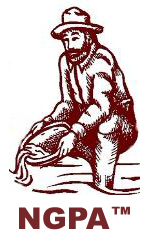Finding Sunken Treasure & Gold on Shipwrecks

Just north of Grand Bahama Island, on the crystal-clear waters of the little Bahama Bank, the Research Vessel Beacon serves as an unusual “Summer home” to some twenty crew members of Maritime Archaeological Recovery Ltd., (M-A-R).
Under the leadership of Captain Herbert Humphreys, Jr., owner of M-A-R and a licensed captain in the United States Merchant Marine, the crew has completed the fourth salvage season on Nuestra Senor de las Maravillas. The Maravillas, a fabulously rich Spanish galleon, sank on January 4, 1656 with a cargo worth an estimated $1.6 billion by today’s standards. The galleon is widely recognized as one of the richest shipwrecks ever.
“The Maravillas was headed home with a cargo destined for the treasury of King Philip IV of Spain,” Humphreys said. “She collided with another ship in the flotilla, or fleet, and sank during a storm.” Although the Spanish attempted to salvage part of the Maravillas, they only succeeded in recovering artillery and coins. In the mid-70Õs, the wreck was rediscovered and worked for a short time. Then, in 1986, M-A-R was granted the contract on the Maravillas by the Ministry of Transport in the Bahamas. All salvage seasons have been well spent, with the last two summers resulting in the richest recoveries yet.
“With the tremendous finds from July of 1988 and August of 1989, I am confident we are on the “scatter pattern” of the galleon’s stern (rear) portion,” explained Humphreys. “We located the bow right off, but the bulk of the treasure was always stored in the stern. The Maravillas, due to age and variable weather conditions, is scattered over a huge area of the ocean floor. it’s only a matter of time before we hit the main pile,” Humphreys concluded.

The appearance of a shipwreck differs entirely from the movie version, where a fierce octopus presides over a treasure chest from a watery grave. Only if the wreck is extremely deep, in cold waters, is the ship somewhat preserved. In addition, coral encrustation coats the artifacts and the only treasure which remains unchanged by time is gold.
M-A-R, vice president and consultant, Art Hartman, likes to say, “If you have ever taken a swim, whether in salt water or fresh water, you have likely passed by thousands of dollars in treasure.” Hartman is referring to the changed nature of treasure and artifacts, especially the silver coins which turn black with time. After a reverse electrolysis procedure, the silver is restored to its original shiny state. At the very most, gold treasure will only have a small bit of coral encrustation which can be carefully removed.
M-A-R “Struck gold” in the summers of 1988-89. During the recent season, exquisite gold jewelry, uniquely different from any past recoveries, was located, creating high spirits among the crew. The most unusual gold finds consisted of: 13 feet of gold chain; a large piece of gold jewelry, chandelier-shaped and oriental in design; a delicate gold filigree pendant; a large gold locket; gold religious pendants called reliquaries; gold pins; intricate gold ornaments in triangular and rectangular shapes and a 2-pound gold disc.
“We found a few gold bars on this wreck last year, but the gold disc was first,” Humphreys said. “Now we just want to find a few thousand more.”
In July of 1988, M-A-R recovered a large amount of treasure, also in the form of gold and jewels. Among those finds were an enormous emerald and gold pendant, emerald and gold rings, diamond and gold rings, a gold pendant in the shape of a turtle with 25 diamonds, gold lockets, gold reliquaries and two gold bars.
The company has consistently recovered silver pieces-of-eight, uncut emeralds and amethysts, silver plates and spoons, pottery shards, weapons, anchors, clay pipes, tools, utensils, Ming Dynasty shards and a wide variety of other artifacts. During a single dive, 511 silver coins were recovered and the largest emerald ever recovered from a shipwreck (100.85 carats!) was found by M-A-R Chief Diver, Arnie Chevalier.
Under the terms of their contract, M-A-R receives 75 percent of all treasure recovered, with 25 percent going to the Bahamian government. Unlike most treasure hunting operations, Humphreys has funded the Maravillas project on his own, with no participation by outside investors. Preservation, he believes, is the first and foremost goal of treasure recovery.

“Every nail, every little pottery shard, each musket ball, literally everything we find is treasure to me. We have an artifact preservationist on board, First Mate Rene Charette, who dedicates himself to preserving these important time capsules of the past. I want to share the results of our work with the public,” stated Humphreys.
M-A-R opened a museum on Grand Cayman Island, British West Indies, in 1987 to display their finds and educate people about the excitement of treasure hunting. Humphrey’s Caymanian partner, Beacon Chief Engineer Kem Jackson, divides his time between the ship and the museum attraction. In addition to the museum, Humphreys owns Holiday Inn Grand Cayman and a variety of businesses in his hometown of Memphis, Tennessee.
The crew of M-A-R possess unique abilities. These men, who share the excitement of the hunt in an atmosphere of camaraderie include: Colby Jackson, Navigator; Oscar King, Second Mate; Col. G. Lee Tippin, Security Chief/Author; Alan Greenspan, Electronics Officer; Henry Hudson, ships Cook/Diver; Allen Mueller, Systems Developer; David Greenspan, Equipment Specialist/Diver; Pablo Martinez, Steward/Diver and Mark Edgar, Seaman/Diver.
Art Hartman”s treasure recovery vessel, Dare, is frequently employed at the Maravillas’ site. His able crew include: Ginny Martin, ships Cook; Darryl Cunningham, Diver/Seaman; and Mike Cundiff, Diver/Seaman. The Dare crew operate the magnetometers, hopefully to pinpoint “hits” for further exploration. The “mags” detect the presence of ferrous metals on the ocean floor, possibly indicating anchors, cannon and, sometimes, an automobile chassis or air conditioner.
Humphreys, who is 41 but easily looks half his age, has wrestled with a lifelong obsession for treasure hunting-and-finding. Typically, he is the first diver out in the morning and the last to climb aboard that night. Treasure seems to gravitate toward him and he has made the majority of the most valuable recoveries. But his best treasure-finding memory occurred when he was a seven-year-old boy.
“I found a gold coin on Montague Beach in the Bahamas,” he recalled. “From that moment on, I was hooked. I had visited many museums and traveled extensively with my parents. But nothing else I saw in the world could match the excitement I felt when I picked up that coin.”
When Humphreys was sixteen, his father gave him a book, Fells Guide to Sunken Ships of the World. Inscribed on the inside cover were these words: “Hope you find $10,000,000! Love, Dad.” Humphreys still has the book on the Beacon today, and its well-thumbed pages attest to the determination of its owner.
Although Humphreys is exploring future possibilities for salvage, he remains committed to finding the Maravillas’ main pile. Perhaps next summer will be the year he and his crew locate the long-awaited, much pursued, “Mother Lode.”
TECHNICALLY SPEAKING…
The Research Vessel Beacon, flagship of M-A-R Ltd., is one of the most sophisticated marine exploration ships on the seas today. Before Captain Herbert Humphreys, Jr. purchased her in 1983, the Beacon was a cable-laying vessel working off the coast of Brazil. Humphreys, along with Chief Engineer Kem Jackson, completely refitted the ship with modern navigation, communication, sensing and excavation equipment.
The ships satellite navigation systems are used with land and sea locations throughout the world. A computerized chart-making system maps out immediate and future locations for future exploration. A weather FAX provides updates on conditions. Depth finders provide depth and profile pictures of the ocean floor. A gyro-scope and computerized automatic pilot is included in the ships navigation system.
The Beacon carries a working crew of 20. Air-conditioning, fully-equipped galley (kitchen), TV, VCR, stereo and a huge library provide diversion and relaxation for crew members. A complete laboratory is located on the upper deck, so artifacts and treasure can be treated and preserved immediately. Six anchors, a power winch and a six-ton capacity crane make salvaging easier. On board are 60 SCUBA tanks, three air compressors, a mini-submarine, a glass bottom boat, magnetometers (ferrous metal detectors to locate anchors, cannon and the like), one diesel engine lifeboat, one large work boat and rubber life rafts.
The divers utilize underwater jackhammers, chisels, power saws, air lifts (underwater “Vacuum cleaners”), underwater life support and communication systems. The most important excavation tools on board are the “blowers” or “Mailboxes”. These large elbow-shaped tubes redirect the ships propwash to the ocean floor when lowered. Since the Maravillas is covered by 30-50 feet of water and 10-20 feet of sand, the blowers save valuable time in the search for treasure and artifacts.
One excavation tool common to some treasure hunters are explosive devices. M-A-R is totally opposed to such measures, for the protection of the reef and respect for marine life are always top priorities.

